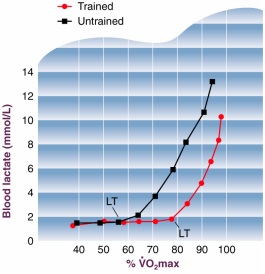Written by Exercise Biologist Philip Mok
 If I were to take away only one thing from my upper division Exercise Biology classes at UC Davis, it would be that lactic acid is not the cause of fatigue during a workout nor is it responsible for the soreness experienced afterward. My professors were determined to dispel this common misconception and for good reason. While it is true that there is a build-up of lactic acid during exercise, blaming lactic acid for causing fatigue is like blaming the ocean for sinking the Titanic. Sure the ocean was there, but we all know that it was an iceberg that caused her maiden voyage to go awry. And soreness? Lactic acid leaves yours muscles within an hour of ending your workout; soreness takes days.
If I were to take away only one thing from my upper division Exercise Biology classes at UC Davis, it would be that lactic acid is not the cause of fatigue during a workout nor is it responsible for the soreness experienced afterward. My professors were determined to dispel this common misconception and for good reason. While it is true that there is a build-up of lactic acid during exercise, blaming lactic acid for causing fatigue is like blaming the ocean for sinking the Titanic. Sure the ocean was there, but we all know that it was an iceberg that caused her maiden voyage to go awry. And soreness? Lactic acid leaves yours muscles within an hour of ending your workout; soreness takes days.
Lactic Acid is your friend
Lactic acid is produced when your body uses carbohydrates such as glucose for energy during anaerobic (without oxygen) metabolism. With physical activity, any lactic acid that gets produced is gladly used as an alternative fuel for aerobic (oxidative) metabolism which primarily runs on fat. Thus, as soon as lactate acid is produced, it is used as a source of energy. As your workout increases in duration and/or intensity, there is a shift within your body. Aerobic metabolic pathways become exhausted, leaving only anaerobic pathways to provide energy for your muscles.
Blood Supply
The distribution of blood within your body influences that type of fuels that are used for energy. To ensure that your active muscles are receiving the proper amount of blood, your central nervous system shuts off blood supply to parts of the body that are not going to be used during exercise such as adipose (fat) tissue. As fat is the primary energy source for aerobic metabolism, anaerobic sources must be used to maintain the demand for energy.
The Size Principle
According to the Size Principle, small Type I, oxidative, slow twitch muscle fibers are recruited first. These fibers utilize fats and lactic acid as fuel. As the work load becomes too great for Type I fibers to keep up, large Type II, glycolytic fast twitch fibers are recruited. These fibers utilize carbohydrates as fuel and produce lactic acid. Type II fibers are meant for producing large amounts of force, not for endurance.
Lactate Threshold
Once your Type I muscle fibers have become completely exhausted, Type II muscle fibers must pick up that slack. This causes your lactic acid levels increase exponentially because your body’s demand for lactic acid has gone to zero as its supply steadily increases. At this point, Lactate Threshold has been reached and you won’t be able to continue to exercise at this level for very much longer. Fatigue is caused by your aerobic metabolic pathways becoming exhausted, not because you have excess amounts of lactic acid. Lactate Threshold is usually met at 50%-60% of VO2max but training can significantly delay it, allowing you to maintain a higher intensity for a longer amount of time.
Lactic acid got a bad reputation in the early 20th century when a scientist named Dr. Otto Myerhoff cut a frog in half, put the bottom half in a jar, and gave electrical shocks to the leg muscles. Because the legs had no source of oxygen, anaerobic pathways were used when the muscles twitched. After a few twitches the legs became fatigued and upon further inspection, contained large amounts of lactic acid. This lead Dr. Myerhoff to theorize that lactic acid was the cause of fatigue. His theory was disproven in the 1970s by Dr. George A. Brooks. For some reason coaches and PE teachers insist that Dr. Myerhoff is still correct and continue to teach the youth of America that lactic acid is their worst enemy. Unless you are a frog who is about to get his legs cut off, lactic acid is your friend.



